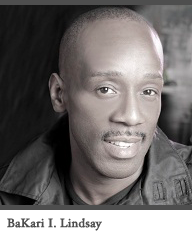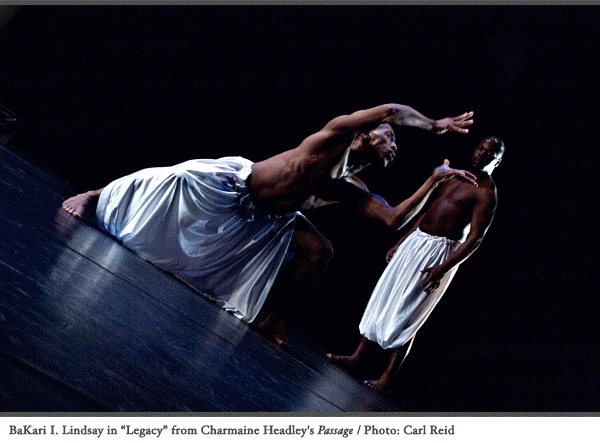| 
next page l enter dancing home  BaKari Ifasegun Lindsay was born on the sunny isle of Trinidad, West Indies. Perfecting his crafts for the past twenty-five years, BaKari is a dancer, choreographer, researcher, singer, musician, costume designer/maker and father. He studied at the Alvin Ailey American Dance Theater, the School of Toronto Dance Theatre (STDT) on scholarship, and with various teachers from the Caribbean and the African continent; he holds a Master's degree in dance ethnology and a Bachelor of Education degree from York University. BaKari developed a physical language for training in West African and diasporic African dance culture entitled A-Feeree – The Physical Language. BaKari Ifasegun Lindsay was born on the sunny isle of Trinidad, West Indies. Perfecting his crafts for the past twenty-five years, BaKari is a dancer, choreographer, researcher, singer, musician, costume designer/maker and father. He studied at the Alvin Ailey American Dance Theater, the School of Toronto Dance Theatre (STDT) on scholarship, and with various teachers from the Caribbean and the African continent; he holds a Master's degree in dance ethnology and a Bachelor of Education degree from York University. BaKari developed a physical language for training in West African and diasporic African dance culture entitled A-Feeree – The Physical Language.
Co-founder of COBA (Collective of Black Artists), BaKari has danced for Danny Grossman Dance Company (DGDC), Artcho Danse Repertoire (Haiti), Jubilation Dance Co. (USA), Toronto Dance Theatre, National Dance Company of Trinidad and Tobago (T&T), Les Enfants Dance Co (T&T) and several independent choreographers in Canada, the United States and the Caribbean. He also appeared in the original performing cast of Canada's production of Disney's The Lion King. BaKari has choreographed works for Les Enfants Dance Co., Entre Deux and The National Dance Company of T&T, while also creating a body of work on COBA. He is on the faculty of Ryerson University and has taught dance at York University, Humber College, Lester B. Pearson School for the Performing Arts in London, Ontario, and for several dance schools, institutions and community groups. BaKari's personal artistic vision is to develop a harmonious balance between artistic practice and traditional cultural values. Carol Anderson spoke with BaKari Ifasegun Lindsay on June 28, 2012, at her Toronto home. 
Carol Anderson: What is the story of your immigration to Canada? When and why did you decide to make Canada your home? BaKari Lindsay: I came to Canada in 1989. At the time, most of my friends were going to New York, but I knew I did not want to do that. I'd been there – in 1985 I got a scholarship to the Graham School and had a concurrent scholarship to the Ailey School. So I studied in New York for a year. I loved it – loved the training, loved the atmosphere, but somehow knew if I was going to become a professional, New York was not the place I wanted to be. The energy wasn't supportive; there was too much competition. It wasn't about being a dancer so much as about competing all the time. I didn't like that. Plus, I didn't have a lot of ballet training – so I was looking for a modern dance school. I flipped through dance magazines for months on end. I remember seeing the Toronto Dance Theatre ad for its “modern dance school” and thinking, “Okay, this must be the place.” So, that was the first thing that got me, and that was the reason I picked Toronto. And Patrick Parson [dancer/choreographer/founder of Ballet Creole] and Greg O'Cready had been here the year before and they had gotten scholarships to the School of TDT. I thought, well if they could go to the school, and get scholarships, there was nothing to stop me from going. So I came to Toronto and auditioned for the school – and didn't get a scholarship. But I was determined to come here and study. I was dancing with a folk dance company that came to Toronto fairly regularly each year – it was in the days of Caravan [an annual series of free community events that offered tastes – food, music, dance, etc. – of various cultures in Toronto]. The year I decided to come here, the company was invited to perform at the Caribbean Pavilion, showcasing Trinidad. So I said, “Okay, but to let you know, I'll come to Toronto with the company, but I will not be returning.” They said, “As far as immigration goes, once your contract with us is over and you change your status, it will be okay.”While I was in Toronto I called STDT and said I was interested in the school, was in Toronto and wanted to audition. They said, “Oh there are summer classes going on. Come and take class.” It was David Earle's fourth year advanced Graham class. I thought, “I studied Graham at the Graham School – it couldn't be that terrible.” Class started – all I remember is “And …” and the last pose of turns around the back [the concluding exercise of a very challenging, extended floor work sequence that begins a Graham class]. That's all I remember. “And” – that's all he said, and everyone knew what was happening. I remember finishing turns around the back and thinking, “My God. This is insane.” Anyway I survived and went to the school. I think I got a scholarship in my second year at the school. That's why I ended up in Toronto. 
I love Graham. I was introduced to Graham by a few teachers who were visiting Trinidad. I love the technique, and fortunately, for a man, I had open hips – that's a huge deterrent for a lot of men, but it wasn't for me. I started dance late – so the kind of depth of commitment and maturity that's required seemed perfectly natural to me. A lot of people who started dancing later find that very strange and odd, but I loved Graham. I loved the expression of it, the passion of it. It was perfectly fine. The first year was hard, and I had to adjust. I mean Martha was still alive while I was at the Graham School, and I had really hardcore people for my training there – so STDT was like a breeze. This was a picnic! It took me a while to understand – they always emphasized that it was Graham-evolved technique. I kept having to say to myself, “This is different.” But Peter Randazzo was pretty close to what I was used to – so there was a nice balance. It was interesting – I remember our first lecture-demonstration, which always includes a lot of the “old stuff” – classic Graham technique. A lot of the students had no clue, but it was familiar to me. So in the later days at STDT, I was able to take advantage of my earlier training. A lot of the “old stuff” was coming through in Trish [Beatty]'s work, and Peter's work. In classes, it was more fluid – but a lot of the choreography referred to earlier Graham work. So it paid off.My initial training was folk dance. I was fortunate, since our primary choreographer was a modern dance person. She choreographed the work, and there was a gentleman who would actually teach the material, but she would choreograph it – so I had an early, very contemporary experience, and my training was essentially contemporary, though my first performance experience was primarily folk dance. In some ways, the woman I'm referring to considers herself a contemporary choreographer – and her ideas about Caribbean folk are very contemporary. Her name is Joyce Kriton, and the company is Les Enfants Dance Company – The Children's Dance Company. She used to be a school teacher. She started the company for kids at school, and when she left the school, she just kept the name. The training was Graham-based. We had quite a number of people who had immigrated to the United States – Peter London was one – who were Graham-trained and would come back on occasion and reacquaint themselves with the Island. There were some Juilliard graduates – so they offered training in the usual US “big ones” – Limón, Graham and Horton, which has a great deal to offer for Caribbean folk dance with its lateral lines. There was a love affair with Graham – it's powerful and it connects well. I've been fortunate, in most of my dance training, to be mentored by elders; they instilled in me a real respect for the tradition. Though we were doing folk dance, it was more folk tradition – we were made to understand that a legacy was being passed on to us with the hopes that we would also be passing it on. That sort of expectation always stayed with me and I think even through moving to Canada, it's just right there, as a core belief. I was given all these gifts, and it's important to share them with other people, share them in a way that is respectful and that honours the tradition. That is the huge connection I keep to the folk tradition. | |

